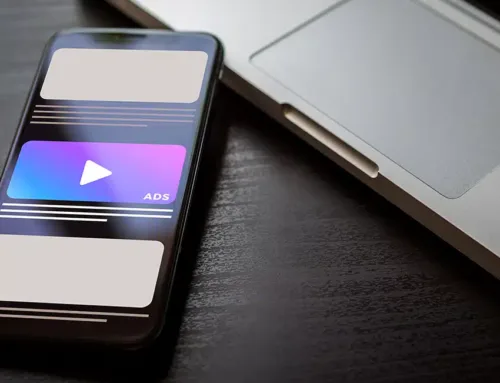Guide To Mobile Programmatic Advertising
Unlock the power of mobile programmatic advertising, a key component of digital marketing that streamlines ad buying through automation and data-driven targeting. This article explores its workings, benefits, and practical tips for leveraging its capabilities in your mobile advertising strategy.
Key Takeaways
- Mobile programmatic advertising uses AI algorithms to automate the buying and selling of mobile ad space in real-time, facilitating targeted campaigns and efficient audience reach through platforms like DSPs.
- Different types of programmatic deals, such as open marketplaces, private marketplaces (PMPs), and programmatic direct, offer varying levels of exclusivity and control over ad inventory procurement, impacting the strategies of advertisers and publishers.
- Real-Time Bidding (RTB) enhances the efficiency of programmatic ads, increases publisher revenues, allows precise audience targeting for advertisers, and involves auction processes like first-price and second-price to determine ad costs.
Understanding Mobile Programmatic Advertising
Mobile programmatic advertising is an automated process powered by AI algorithms. These algorithms tap into vast user data from mobile apps to buy and sell mobile ad space, including mobile ads, in real-time, enabling customized campaigns and effective audience targeting.
Ad spaces are allocated through real-time auctions. In these auctions, algorithms analyze user data and bid on ad space instantly. Demand Side Platforms (DSPs) facilitate this process, ensuring the immediate display of the most relevant ads to users.
The Evolution of Mobile Advertising
Mobile advertising has evolved remarkably from SMS in 1992 to today's era of interactive mobile video ads. The evolution and growing sophistication of mobile technology have paved the way for engaging forms of advertising, such as interactive gaming, GPS technology, and most importantly, mobile programmatic advertising. As a result, the mobile advertising industry has experienced significant growth and transformation.
The rapid expansion of the mobile advertising market, coupled with the evolution of programmatic advertising, has led to mobile devices commanding the majority of global digital ad expenditure today. Programmatic advertising has automated the media buying process, facilitated real-time bidding, and considerably transformed the media landscape.
Key Components of Mobile Programmatic
Demand Side Platform (DSP) is an important component of mobile programmatic advertising, serving as a key tool for advertisers to reach their target audience with efficiency and precision. It serves as a platform enabling advertisers to procure and manage ad inventory, which includes video, mobile, and search ads. On the other hand, ad exchanges facilitate the efficient buying and selling of digital inventory through Real-Time Bidding (RTB).
Data Management Platforms (DMPs) are also instrumental in this ecosystem. They collect, organize, and analyze data from diverse sources to help advertisers and publishers effectively target their audiences.
These components work together to streamline the ad buying and selling process, making mobile programmatic advertising a promising avenue for the future.
Types of Mobile Programmatic Deals
In mobile programmatic advertising, various types of deals are available, including ad exchange platforms and mobile display ads, such as mobile banner ads. An open marketplace is one where advertisers have the liberty to acquire display ads on a publisher's site with minimal restrictions.
On a more exclusive front, there are Private Marketplaces (PMPs). Here, a publisher selectively invites a limited audience of advertisers to bid on its inventory in a real-time bidding environment.
Then there's Programmatic Direct, where an agreement between the advertiser and publisher is fixed. This model guarantees that the advertiser receives a predetermined number of impressions at a fixed price.
Real-Time Bidding in Mobile Programmatic
Real-Time Bidding (RTB), a cornerstone of mobile programmatic advertising, enables instantaneous buying and selling of digital ads on a per-impression basis. The bidding process in RTB is influenced by various factors, including contextual and longitudinal elements such as time of day and year, country, ad slot sizes, and the operating system.
RTB offers myriad benefits to advertisers and publishers in mobile programmatic advertising, including:
- Enhancing the efficiency of buying and selling programmatic ads
- Enabling streamlined, efficient, and targeted purchasing
- Increasing revenue and fill rates for publishers
- Expanding access to potential buyers
- Providing greater control over the bidding process
The Auction Process
The auction process in real-time bidding for mobile programmatic advertising orchestrates the instantaneous buying and selling of ads on a per-impression basis. In a first-price auction, the winning brand pays exactly their bid amount, facilitating smooth simultaneous bidding and fostering competitive offers.
A second-price auction, on the other hand, makes the winning bidder pay slightly less than their bid. This auction format promotes equitable bidding and diminishes the risk of bid manipulation, although it may introduce complexity in strategic decision-making for buyers due to the uncertain final price.
Advantages of RTB for Advertisers and Publishers
RTB provides many advantages to advertisers, including:
- Precise targeting through the use of real-time data
- Empowering advertisers to bid for ad impressions in real-time, thus enabling them to tailor their ads to specific audiences
- Cost efficiency is due to the automation of the ad-buying process, which allows marketers to allocate their budgets more effectively
For publishers, RTB offers:
- Increased revenue and fill rates
- Expanded access to potential buyers
- Greater control over the bidding process
- Improved pricing accuracy
- Enhanced value of unsold ad space
- Valuable audience insights
Optimizing Your Mobile Programmatic Campaigns
Mobile programmatic buying involves the automated purchasing of ad space on mobile devices, using data-driven algorithms to target specific audiences and optimize campaign performance in real-time. To optimize mobile programmatic campaigns, one must focus on top-funnel metrics, bottom-funnel metrics, and creative ad KPIs, guaranteeing success and high-value user acquisition. To enhance top-funnel metrics, advertisers can utilize key performance indicators such as impressions and reach to assess the success of brand awareness.
The influence of creative ad KPIs on the success of a mobile programmatic campaign is significant as they aid in effectively scaling the campaign and meeting the KPIs. To enhance these performance indicators, advertisers can employ responsive ad creative, conduct tests on different ad elements, and analyze metrics for continuous enhancement.
Top-Funnel Metrics
Impressions, reach, and CTR (click-through rate) are the primary metrics to consider at the top of the funnel in mobile programmatic campaigns. The significance of CPM in top-funnel metrics lies in its measurement of campaign impressions, assisting advertisers in capturing the attention of a broad audience.
The CPM model in mobile programmatic advertising enables the optimization of metrics closely associated with Lifetime Value (LTV), such as return on ad spend (ROAS). One strategy to enhance performance in mobile programmatic advertising by targeting metrics associated with LTV is to utilize the CPM model and concentrate on metrics such as return on ad spend (ROAS).
Bottom-Funnel Metrics
Bottom-funnel metrics focus on strategies for user retention, evaluating new user values, and measuring return on ad spend. The value of new users in mobile programmatic advertising campaigns can be determined using the concept of LTV.
Cost per action (CPA) is a pricing model in mobile programmatic advertising where advertisers are charged for specific actions or conversions resulting from their ads. Return on ad spend (ROAS) in mobile programmatic advertising can be quantified by dividing the total revenue generated from an ad campaign by the total cost of the ad campaign.
Creative Ads KPIs
Certain creative ads KPIs such as CTR, IPM, CR, and IR are pivotal in assessing the performance of mobile programmatic ads. Click-Through Rate (CTR) in mobile programmatic advertising is a marketing metric used to measure the frequency of clicks on a link, ad, or email in comparison to the number of times it is displayed.
Install Per Mille (IPM) in mobile programmatic advertising involves dividing the number of installs by the number of impressions, and then multiplying the result by 1000.
Conversion Rate (CR) denotes the proportion of users who accomplish a desired action on a website subsequent to clicking on a mobile programmatic ad.
Interaction Rate (IR) represents the frequency of user engagement with an ad relative to its total views.
Choosing the Right Mobile DSP for Your Campaign
A mobile DSP, or a demand-side platform, acts as an automated tool for purchasing digital ad space on mobile devices. When selecting a mobile DSP for programmatic advertising, it's crucial to consider:
- Data handling capabilities
- Inventory evaluation
- Technology
- Brand-safe capabilities
- The rapport with the DSP team.
Technical capacities dictate the platform's ability to track and collect essential data regarding ad effectiveness, such as:
- Impressions
- Ad viewability
- Clicks
- CTR
- Conversions
Considering the available inventory is crucial because it directly impacts reach and relevance of ad campaigns. The selection of ad formats is critical as they must align with the campaign's objectives for user engagement and effectiveness.
Benefits of Mobile Programmatic Advertising
Mobile programmatic advertising offers a range of benefits, leveraging user data, including demographics and behaviors, to strategically position ads before the right audience at the most opportune time and place, thereby boosting ad effectiveness. It's also cost-efficient due to the automation of the ad-buying process, allowing marketers to allocate their budget more effectively.
A programmatic mobile platform enables advertisers to automate the buying and selling of ad inventory across various mobile devices and apps, maximizing efficiency and targeting capabilities.
For publishers, mobile programmatic advertising offers:
- Increased revenue and fill rates
- Expanded access to potential buyers
- Greater control over the bidding process
- Improved pricing accuracy
- Enhanced value of unsold ad space
- Valuable audience insights
Overcoming Challenges in Mobile Programmatic Advertising
As with any technology, mobile programmatic advertising presents its own set of challenges, such as:
- High fragmentation in audience targeting
- Ad fraud
- Issues with viewability
- Guaranteeing inventory quality
Ad fraud can be mitigated through the use of ad verification tools, close monitoring of traffic sources, and partnering with reputable programmatic advertising marketplaces.
Data privacy concerns can be mitigated by implementing stringent data protection measures, obtaining explicit user consent for data use, providing transparency and user control over their data, and ensuring compliance with privacy laws.
Improving viewability can be achieved by optimizing ad placements and targeting specific audiences, all while prioritizing strategies that uphold a positive user experience.
Case Studies: Success Stories in Mobile Programmatic Advertising
Real-life case studies serve as the best evidence of the potential of mobile programmatic advertising. For instance, some brands have utilized programmatic advertising to achieve higher returns on ad spend. Numerous successful case studies of user acquisition through mobile programmatic advertising are available, detailing how brands have managed to reach their target audience effectively.
Mobile programmatic advertising, including mobile programmatic video advertisements, showcases efficient budget allocation and the reduction of wasted ad spend. These case studies provide a glimpse into the true potential of mobile programmatic advertising, demonstrating how it can revolutionize the digital advertising landscape.
Summary
Mobile programmatic advertising is a powerful tool in the hands of marketers. It's all about using AI-powered algorithms to optimize ad buying and selling in real-time. With the right strategies and understanding, marketers can leverage mobile programmatic advertising to reach the right audience at the right time, resulting in increased ROI and improved user acquisition. It's a promising avenue for advertising, overcoming traditional methods' limitations, and offering a whole new world of possibilities.











